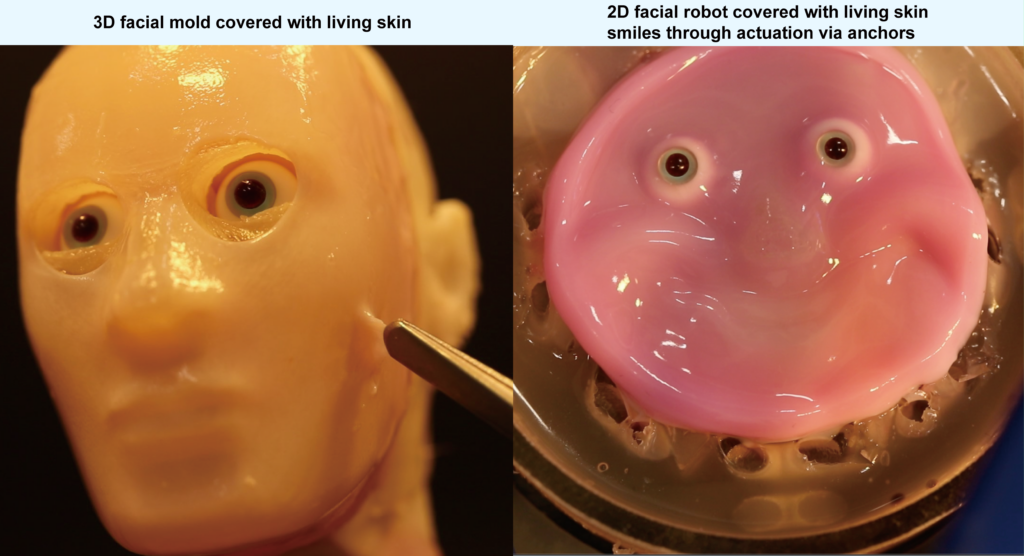
Source: https://xkcd.com/3133/

Source: https://xkcd.com/3133/
As predicted here 4 years ago, giving a VC-funded cloud-based animated robot as an emotional companion to your child is a risky move.
With VC funding drying out, the startup behind this “amazing” concept has to turn off the cloud computers needed to keep these teddy bears “alive”.
Since Embodied marketed Moxie as a companion and development toy for children, there’s concern about kids potentially suffering an emotional toll after the robot abruptly becomes inoperable.
I will not post here the viral video of a father announcing the news to his crying child. Why would you even film something like that?
Researchers are exploring using livable human skin to cover a mechanical apparatus. Apparently, human skin has interesting properties for robots also.
To demonstrate this concept, they’ve recreated a human face.
“In this study, we managed to replicate human appearance to some extent by creating a face with the same surface material and structure as humans,” said Takeuchi. “Additionally, through this research, we identified new challenges, such as the necessity for surface wrinkles and a thicker epidermis to achieve a more humanlike appearance. […] Of course, movement is also a crucial factor, not just the material, so another important challenge is creating humanlike expressions by integrating sophisticated actuators, or muscles, inside the robot.
https://www.u-tokyo.ac.jp/focus/en/press/z0508_00360.html
Dude, you’re going to have to do better than putting 2 googly eyes on a petri dish to call this a human face. But at least it seems you’re having fun.

Robots won’t steal our jobs, they’ll make us work for them.
(source)
Some battle-hardened warriors treat remote-controlled devices like brave, loyal, intelligent pets, while others describe them as clumsy, stubborn clods. Either way, observers have interpreted these accounts as unsettling glimpses of a future in which men and women ascribe personalities to artificially intelligent war machines.
https://spectrum.ieee.org/military-robots
This is gross and amazing at the same time.
Driverless cars are often called autonomous vehicles – but driving isn’t an autonomous activity. It’s a co-operative social activity, in which part of the job of whoever’s behind the wheel is to communicate with others on the road. Whether on foot, on my bike or in a car, I engage in a lot of hand gestures – mostly meaning ‘wait!’ or ‘go ahead!’ – when I’m out and about, and look for others’ signals. San Francisco Airport has signs telling people to make eye contact before they cross the street outside the terminals. There’s no one in a driverless car to make eye contact with, to see you wave or hear you shout or signal back. The cars do use their turn signals – but they don’t always turn when they signal.
“In the Shadow of Silicon Valley” by Rebecca Solnit
I love how this little thing balances itself.
They call them arms, but they look more like fingers to me.
Obviously, their creators care about it. It’s so cute how they try to push it off-balance without hurting it.
Rothing speaks bullshit more than an android nobot in a wheelchair tele-operated by a white dude wearing Hololenses, as if he was in some kind of alternate hospitality world we’d all want to live in.
Making it a square video does not make it cooler either.
“Remote caregivers”, I suppose that’s what they call “robodies”, providing “companionship”, “genuine human connection” and “the warmth of human interaction” is now a “comforting reality”, says the soothing female narrator voice trying to hit every keyword in the marketing 101 playbook.
“Nurturing human connection, enriching lives and redefining the essence of care”, more like nurturing the techno dream of total surveillance, enriching stock value for shareholders and pouring gasoline over healthcare.
Let’s 3D scan your heart, build a 3D printed replica, roboticize it with actuators and test surgery procedures on it before we do it on your real heart.
This takes “human cloning for medical purposes” in a somewhat unecpected direction.